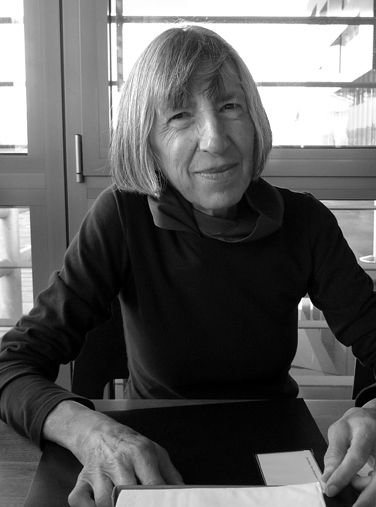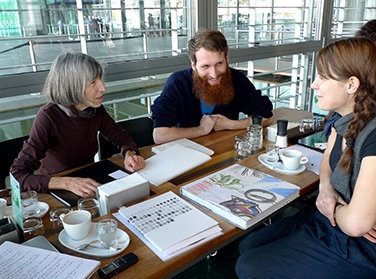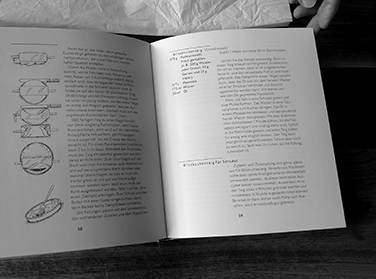Interview
Dora Wespi is a Swiss graphic designer and illustrator. Determined and independent, she was influenced and guided by her non-conformist teacher Hans-Rudolf Lutz to enter the male-dominated field of graphic design.
Born in Reiden, Wespi undertook an apprenticeship and attended professional school before completing her studies in graphic design at the Schule für Gestaltung in Lucerne, where she was taught by Lutz. Upon his recommendation, she completed an internship at the progressive Hollenstein Studio, in Paris, in 1973.
Upon her return to Switzerland, Wespi worked as a freelance designer. Her passion for drawing developed into a personal and artistic practice and also led to many illustration commissions. Since 1978, she has had and participated in several solo and group exhibitions, and in 1999 published an artist book titled Dora Wespi, Serielle Arbeiten, A6, 1983–1999 in memory of her lifelong mentor and friend Hans-Rudolf Lutz.
Owing to her connection with Lutz, Wespi was able to create and publish three covers for Typographische Monatsblätter, characterized by original and thoughtful typographic compositions based on selected text excerpts. She taught at the Hochschule Luzern’s department Design & Kunst from 1981 to 2008, receiving the title of Professor in 2002.
Louise Paradis When researching the history of TM, I read that for one cover design you made a typographic interpretation of texts that you had selected, by different authors. Can you talk about your intention for the project, and the process?
Dora Wespi It has to do with the fact that I was a student of Hans-Rudolf Lutz, one of the most important persons in my life. I did my diploma in graphic design here in Lucerne about 39 years ago, back when it was a much more varied discipline. We had classes in photography, illustration, typography, type design, etc. Especially in Lutz’s class, it was really about a variety of things. My graduation went well, and I then badly wanted a job at Josef Müller-Brockmann’s studio. But they didn’t hire me. So I had a little life crisis, and when I went and talked to Lutz he said I should do something for TM; this would keep me going. It seemed interesting but I needed a good idea, ready to show, because I wasn’t Wolfgang Weingart or somebody famous. I felt I needed to prepare something outstanding. And since Lutz had told me that TM was always looking for new ideas I decided to look outside of the visual world, to something else that interested me a great deal, which was literature. I then picked texts by quite different authors, and used them for a series of covers. To my luck, I was protected by Lutz’s good will, and he had told the editors of TM that I will do some covers and that everything would be fine.
LP You designed two covers, one in 1980 and the other in 82, were they meant to be part of a series?
DW I had planned to do more, but I am not sure now why it ended there … It took a lot of effort to produce these covers, and I don’t know if I would have been able to handle more at the time. I had to ask for copyrights, arrange for parts of the text to be translated – and in the process, some of the authors invited me to visit them. It was a bit strange, because some of them just said, “Yes, you can use the text,” and never asked to see the layout.
LP Was TM an important magazine for you? Were there other magazines that inspired you?
DW In Switzerland, TM was totally unique. The scene was pretty isolated, and TM was the most international view you could have. When I was a student, each time a new issue came out everybody would talk about it.
LP There are not many women who designed covers for TM. What do you think the reason for that is?
DM Probably the reason simply is that there are so few women typographers. Even today, there are not that many. Sometimes a woman got married to a typesetter, and got into the profession that way. But actually, in the class there were always more women than men. When I was at design school, we were a group of only 12, and if you were a girl you were not really supposed to be interested in typography. I was an exception. My husband was a trained typesetter, and I was keen to team up with him because at that time setting type was really not a job for a woman—even though I wanted to do it myself. Many people applied for a job in a studio, but I never did. I always worked on my own. Also, I would have never been able to be on my own with kids. All of my female friends who were in the profession and had kids couldn’t work anymore. During all my career, I didn’t do too many plain type jobs. I did a lot of illustrations and I am now an artist. It was also difficult at times, because just when I finished school—when I started to work—the shift from lead type to phototypesetting happened.
LP There have been many technological changes taking place during your career. Do you feel there were also aesthetic and ideological changes taking place in graphic design in the same period?
DW On one hand there was a new belief that everybody could do typography. On the other hand, Basel was the measurement of typography at the time. I was part of the generation of 1968, and we didn’t want to look too much at Basel. We just wanted to use whatever was available and change the world, even though I didn’t go to the streets to claim it. That was the general feeling of that generation: do your thing. Lutz was pretty extreme, and he always said that there is not only Basel. He would always take the opposite side in meetings. The only one that he liked was Weingart, and he invited him to give lectures. Lutz would always say, “Don’t look at the others, just do what you want; do it for yourself.” This was also the difference in his way of teaching, which was more about the ideas: the design would be part of the idea. Whereas in Basel, it was more about the design.
LP Can you tell me more about your work path as a designer?
DW Earlier, I made an internship in Paris, at Albert Hollenstein’s studio, the same place Lutz went to. And upon returning to Lucerne, I would help all the local studios as a freelancer. I had a passion for drawing, so if a client would ask about a brochure I would do everything: illustrations and design. That’s how I succeeded in making a bit of money, even if it was not always very creative. Even one time, someone told me I was too young to do a job and I was 35. And sometimes they wouldn’t give me the job probably because I’m a woman. It was the time you still couldn’t live with your boyfriend without being married—so I got married. I would draw and paint at home and he would work at an agency. In a way, illustration was always very important for me, but there was no apprenticeship for illustration in Switzerland at the time. I could have learned illustration in Germany, but it was out of reach for me, there simply was not yet a system to fund study abroad.
The director of the graphic design school in Lucerne called me years after I had graduated from the same school and said he may have a job for me. It was a position on the Vorkurs [preliminary course], and I would teach typography. I inherited the position from a teacher who retired and who had been teaching calligraphy, and students didn’t like that anymore. At first, I told the director I wasn’t interested to teach and he replied, “But you always said that there were no women in teaching positions.” They even told me, “If you can’t do it, you could ask your husband to help you.” Which was entirely weird for me. I did grow up having a brother, so I never experienced the fight between boys and girls and my parents always raised me as I could do whatever I wanted. I grew up in a modest house and I learnt that if you wanted to do something, you had to push yourself. Maybe as a result I never worked with my husband, and I wanted to do things on my own. If he needed illustrations, he would offer me a job. We only worked together once, on a school book. And we went to the meetings separately: I would meet the clients about the illustrations and he regarding the type.
LP Besides all this work, did you ever have the time to realize your own, personal projects?
DW For a long time I worked on a series of 4 x 6 cm images. I have about a thousand images, all the same format, but with variations regarding the visual appearance and image composition. I came to make a book from it, at about the time when Lutz and I were teaching at the same time for a moment. When Lutz got more and more ill, I would send him some of these 4 x 6 cards with illustrations. And when we met, we always had really nice talks. At around the time when we knew he was probably going to die from his illness, he called me and asked me how many of these cards I have. I said, “I don’t know, maybe a thousand.” He said, “You have to make a book.” I told him, “But I am not like you, I am not famous.” He said, “Do the book and you will be.” So I followed his advice and did a first design of the book and he said, “No, it is not good. Don’t ask your husband to help, it won’t work.” I told him, “I can’t do the design if you don’t help me.” He said, “I can’t help you anymore, you have to do it on your own.” He told me not to go to a publisher, that I had to publish it myself. But, you might know, it is so hard to sell books without a publisher and so now, even many years after he died, sometimes I look at the pile of books in my home and ask Lutz, “And now what?”
The above conversation took place in Lucerne, Switzerland, on November 2010 with Christoph Knoth and Katharina Köhler. It was copy-edited by Ariella Yedgar and Roland Früh.


